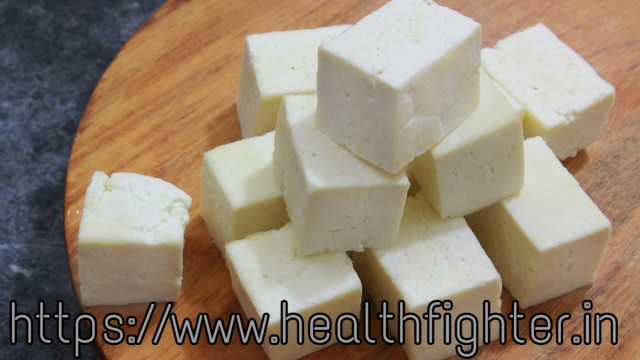Paneer is made by curdling milk using food-derived acid from lemon, vinegar, or citric acid. The curd is then collect in a muslin cloth to separate it from the whey. It is then pressed to create slabs, which is what we buy. The name 'paneer' is derived from Persian 'panir' and its origin has been attributed to Iranian, Afghan, Portuguese invaders and settlers, but whoever introduced it to India, today this mildly flavored, non-melting farmers cheese is an integral part of our diet.
Paneer Nutrition Value and Facts: 40gms Paneer Contains:
| Paneer: 40gms | |
|---|---|
| Protein | 7.54gm |
| Fat | 5.88gm |
| Carbs | 4.96gm |
| Energy | 103.15Kcal |
| Folates | 37.32microgram |
| Calcium | 190.4mg |
| Phosphorus | 132mg |
| Sat Fat | 3540.4mg |
| MUFA | 1720mg |
| PUFA | 175.6mg |
Paneer is a good choice for proteins, In a vegetarian diet. With a biological value of protein is 80-86%, it contains all the nine essential amino acids. As we all know, proteins are the building blocks of our cells; they are also essential for maintaining growth, repairing tissue, keeping our immunity in top shape, maintaining our blood volume and are an essential part of almost every hormone & enzyme. Paneer can replace dals it can be used as a snack and can also be eaten raw. Being bland in taste, it can be flavored to an individual's taste and paired with almost anything, making its consumption easy and hassle-free.
Fats in paneer are about 20% and it is a rich source of saturated fats. But it also has healthy Monounsaturated fats (MUFA). It is associated with lowering the LDL (bad cholesterol) in the blood. Oleic acid, the main MUFA in paneer, has been associated with lowering Blood Pressure. Paneer also contains a fair amount of alpha-linoleic acid, an omega-3 polyunsaturated fat, associated with a moderate lowering of risk of cardiac diseases. Because of a high amount of saturated fats, portion control is essential.
Paneer contains lower amounts of carbs, as compared to dals which help in the Indian diets where carbs are very high as it is.
Paneer can also help increase fat burn because it contains conjugated Linoleic acid, a PUFA fat which is associated with increasing the rate of fat burning in our body. So, those who want to do weight management must include one serving of paneer in their meals.
It is a milk product that's why paneer is a rich source of calcium and phosphorus, both of which are crucial for our skeletal health. Calcium alone may not be able to improve your bone health; it needs phosphorus for optimum use, so if there is a food that gives you both together then it's amazing. Calcium is necessary for our heart muscles and nerves to function properly. Phosphorus is present in every cell of our body and is needed to release energy to maintain the acid-base balance and it also supports growth.
Paneer is also a healthy food choice for diabetics. It is low in carbs and rich sources of protein, which makes it perfect for controlling post-meal sugar argues. I always advise diabetics to start their meal with a couple of bites of protein, it helps prevent an insulin rush, and also proteins in a meal help slow down the release of energy preventing sugar spikes
Paneer
 Reviewed by HealthFighter
on
February 25, 2020
Rating:
Reviewed by HealthFighter
on
February 25, 2020
Rating:
 Reviewed by HealthFighter
on
February 25, 2020
Rating:
Reviewed by HealthFighter
on
February 25, 2020
Rating:



No comments:
Please do not enter any spam links in the comment box